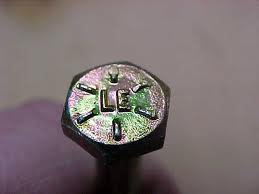A Mini Guide On Grade 8 Bolts
Grade 8 bolts are specified for high strength applications and are commonly used in heavy manufacturing, such as tractor and truck fabrication for instance. The bolts are typically made of a medium carbon alloy steel that is plated in zinc for extra resilience. The grade 8 bolt can be identified via the flat, hexagonal head marked by six radial lines and occupy the highest position on the bolt-rating chart.

The hardest and strongest of the hex bolts
Despite the popular belief, a stainless steel bolt is actually weaker than a grade 8 bolt. In fact, according to the Society of American Engineers (SAE), grade 8 bolts are the strongest and hardest hex bolt you would want to use in constructions or the automotive industry. While the carbon alloy bolts have a proof load of over 120,000 psi, their stainless steel counterparts don't carry an indicative proof load. Moreover, the minimum strength of grade 8 bolts is around 130,000 psi, whereas stainless steel strength doesn't exceed 90,000 psi.
Available in all lengths and diameters
Depending on the particular use, industry as well as the amount of stress and heavy loads it needs to bear, the super strong fastener is available in a wide variety of lengths. The extra length is obtained by extending the grip length, increasing the thread length or both, based on the specific details of the application. It is important to note that the length of the fastener – meaning the distance between the bottom of the head and the end of the screw – is different from what is referred to in most industries as the 'nominal length'. The latter constitutes to the combined combine length of the grip and thread.
As far as the diameter is concerned, grade 8 bolts can be classified by the thread, shank or root diameter. While you can find the data in inches sometimes, you're more likely to see a size number that represents a particular measurements. This is why you should contact the fastener manufacturer and ask about all the technical specification of the bolt in order to make sure that it will fit perfectly. On a side note, measuring the diameter of the head is not a good approach in this case because the shafts can have a bigger or smaller diameter.
Identifying a grade 8 bolt
In the event that you need to replace a fastener on one of the machines and you suspect it's a grade 8 bolt, then all you need to do is check out the marking on the head of the bolt. As dictated by the industry standards, a grade 8 bolt will have six lines stamped into the head that point towards its center. The metric equivalent of the lines is the number 10.9.
If the bolt you're trying to identify is old and rusted, then there's a chance you can't read the markings. In this case, the ideal approach would be to search for the type of fasteners needed in the equipment's manual. In the event this is not an option, then your best bet is to make an educated guess by accounting for the settings of the old bolt and the typically load it supported.
About the Author

Started my career in the fastener world in 1969 at, Parker Kalon Corp. a NJ based screw manufacturer located in Clifton, NJ working in inventory control, scheduling secondary production and concluding there in purchasing. In 1971 I accepted a sales position at Star Stainless Screw Co., Totowa, NJ working in inside sales and later as an outside salesman, having a successful career at Star I had the desire with a friend to start our own fastener distribution company in 1980 named: Divspec, Kenilworth, NJ. This was a successful adventure but ended in 1985 with me starting Melfast in August 1985 and have stayed competitive and successful to date. Melfast serves the OEM market with approximately 400 accounts nationally.